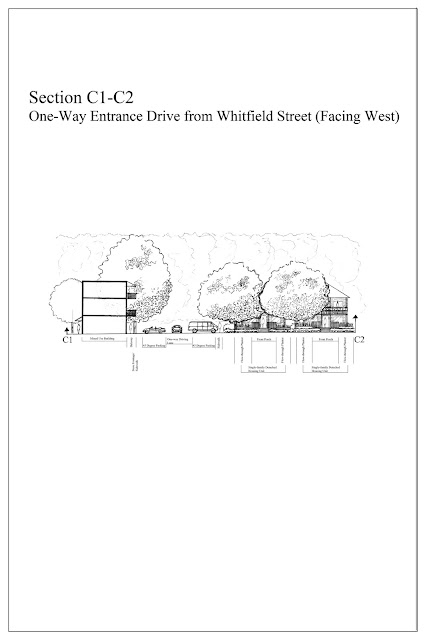Wednesday, December 1, 2010
Infill Housing Development Perspectives
This is an excellent perspective illustrating the view of the waterfeature as seen when being viewed from the north end of the courtyard. This was probably the most influential drawing in the design packet.
This is a good perspective to illustrate the design intent for the public art piece, located on the corner of Scales and Whitfield Streets. After reviewing this drawing, I realize that an element is missing to create an overhead plane, which would make the space feel more intimate. This is a major intersection on the site, so more movable seating should have been designed into this space as well. Overall, I was pleased with all perspectives and other drawings used to support the Infill Housing Development Design Solution for Graduate Studio III, at Mississippi State University.
Infill Housing Development Perspectives
This is a very nice perspective illustrating the recessed stormwater detention facility, located within the courtyard of the single family attached housing units, located in the southeast corner of the site. After reviewing this drawing, I believe this space has been designed to attract people, and therefore promote a strong sense of community.
The purpose of this perspective was to show how the parking for the single family detached housing units was resolved through the design. As seen here, each unit has two paved spaces and one overflow space with a grasspave surface, instead of the paving. This design feature helps break up the monotony of a continuous parking lot while maintaining the benefits of a larger, box style parking lot design.
The purpose of this perspective was to show how the parking for the single family detached housing units was resolved through the design. As seen here, each unit has two paved spaces and one overflow space with a grasspave surface, instead of the paving. This design feature helps break up the monotony of a continuous parking lot while maintaining the benefits of a larger, box style parking lot design.
Infill Housing Development Perspectives
This perspective does a nice job portraying the feeling one would have while standing on the southeast corner of the large play area, located on the north end of the site. I believe this perspective is a strong selling point to this design.
This perspective is not very effective for selling the design, but to be honest, I was rapidly approaching the project deadline and needed ten perspectives. This perspective illustrates how the different elements used to create a strong and healthy pedestrian experience come together in a manner that follows the overall design concept
Infill Housing Development Perspectives
I feel as though this is an effective perspective, but I accidentally drew a vehicle exiting this area. This was a mistake on my part because this street is designed for one-way traffic only, entering from Whitfield Street.
The purpose of this perspective was to illustrate the features creating the environment in the back alley.
Infill Housing Development Perspectives
I feel as though this birds-eye view does a wonderful job illustrating the feel and character of the single family detached housing units
This perspective was very effective in illustrating how the pedestrian crosswalk would be viewed when being approached from the north. It also does a fantastic job illustrating how the trees, planted for the alley effect, would create a very formal central common green.
Details for the Infill Housing Development Project
The following details were used to describe certain features of the design in more detail. Below are three of the details prepared to support the enlarged plan.
The feature addressed by the public art detail is located on the southwest corner of the site, at the corner of Scales and Whitfield Streets. The flow-through planter detail illustrates the planter section between the bike lane and Whitfield Street.
The paver detail is illustrating the pedestrian crosswalk, 45 degree parking stalls, and the one-way driving lane. I believe each of these details was very effective in illustrating the design intent for the corresponding feature.
The feature addressed by the public art detail is located on the southwest corner of the site, at the corner of Scales and Whitfield Streets. The flow-through planter detail illustrates the planter section between the bike lane and Whitfield Street.
The paver detail is illustrating the pedestrian crosswalk, 45 degree parking stalls, and the one-way driving lane. I believe each of these details was very effective in illustrating the design intent for the corresponding feature.
Enlarged Plan for the Infill Housing Development Project
As part of this project, I had to chose a section of my design to illustrate a detail plan. I chose to detail the mixed-use area, located on the southwest corner of the site.
Overall, I was pleased with the product of this phase of the project. After reviewing the plan, there are a few things I wish would have been done differently:
1. Increase the building setbacks to 10 feet, instead of 5.
2. Reconfigure some of the balcony spaces.
3. Provide a greater amount of gathering space within the interior of the courtyard (smaller waterfeature, increased gathering space).
Overall, I was pleased with the product of this phase of the project. After reviewing the plan, there are a few things I wish would have been done differently:
1. Increase the building setbacks to 10 feet, instead of 5.
2. Reconfigure some of the balcony spaces.
3. Provide a greater amount of gathering space within the interior of the courtyard (smaller waterfeature, increased gathering space).
Planting Plan for the Infill Housing Development Project
All raised flow-through planters are planted with a grass/sedge mix. The look of the grasses coming from the planters resembles the old well, which was existing on site but removed in the design. In this manner, the design retains the spirit and feeling of the old water well in a manner which is uniform throughout the entire site. All other plant materials were chosen due to their aesthetic appeal because of texture contrasts, others were chosen to ensure different flower and leaf color alterations throughout the year. Plant materials have also been used throughout the design to define space. Overall, I was pleased with the planting design scheme.
Sections for the Infill Housing Development Project
The sections on this post were used to help support the master plan presented on the previous post. The master plan is presented again on this post to show the location of the cut lines.
After reviewing the final sections, I felt as though interesting spaces had been designed throughout the design which should foster a strong sense of community.
After reviewing the final sections, I felt as though interesting spaces had been designed throughout the design which should foster a strong sense of community.
Infill Housing Development Master Plan
As seen here, the three single family detached houses were set back in order to locate the play area in the openspace between the homes. All open greenspace is slightly recessed in order to act as a retention/ swale for stormwater entering the site. The greenspace, located in the courtyard of the single family attached housing area, is recessed 2 feet for the purpose of holding stormwater on site. The waterfeature, located within the mixed use area, is a very cool feature to this design. This feature is meant to resemble the works of Lawrence Halprin. I feel as though this will help create an inviting space that encourages interaction among residents, as well as with people from other communities. Perspectives, details, and sections will be posted on the next few blog entries. These additional drawings should answer any questions you have about the design, but if you have any questions do not hesitate to ask.
Preliminary Section
The section shown here is from the preliminary plan for the infill housing development project.
This north facing section is cut across the single family detached housing units, located on the northern portion of the site. After reviewing this section and the massing model, which will be shown on a later post, I made the decision to set the last three homes along Whitfield Street back in order to bring the play area into the openspace between the homes, instead of being located between the street and the back of the homes.
This north facing section is cut across the single family detached housing units, located on the northern portion of the site. After reviewing this section and the massing model, which will be shown on a later post, I made the decision to set the last three homes along Whitfield Street back in order to bring the play area into the openspace between the homes, instead of being located between the street and the back of the homes.
Infill housing Development Concept Statement
This post should have been before the Preliminary Plan.
A quilt was my inspiration throughout this design process because, in my opinion, a quilt is a very special item symbolizing many different times, traditions, and preferences throughout history. When I think of a quilt, I see many items that have became undesirable, by themselves, over time, but when transformed and united with other undesirable parts, it becomes a special heirloom that sparks conversation among people that see it.
A quilt was my inspiration throughout this design process because, in my opinion, a quilt is a very special item symbolizing many different times, traditions, and preferences throughout history. When I think of a quilt, I see many items that have became undesirable, by themselves, over time, but when transformed and united with other undesirable parts, it becomes a special heirloom that sparks conversation among people that see it.
Preliminary Plan for Infill Housing Development Project
The plan presented here was the starting point for figuring out how I wanted the spaces to come together and create a development which fosters a strong sense of community. The preliminary plan is presented below.
The housing units located on the northern portion of the site are single family detached units. The buildings located on the southwest portion of the site are mixed-use, with retail on the bottom floor and residential units located on the upper floors. The buildings located on the southeast portion of the site are single family attached housing units. The road running west to east across the site is one way, entering from Whitfield Street. There is an alley running north to south allowing for two-way, local traffic. The common green running through the site will also act as a stormwater retention basin, as well as the courtyard located in the single family attached housing area. The next few posts will show the progression from this point to the final design solution.
 |
Inventory and Analysis for Infill Housing Development Project
The following sheets briefly summarize the major information gathered during the inventory and analysis process.
This map illustrates the City of Starkville's zoning classifications within a five, and ten minute walking radius from the site.
This solar study illustrates the angle of the sun during the summer and winter solstice. From this diagram, it was determined that the roof overhangs needed to be at least 3.5 feet in order to protect the home from the hot summer sun.
These wind rose diagrams illustrate the wind direction and intensity for each month of the year. This information helps determine locations of wind screens or features to enhance the breezes.
This diagram illustrates the roads within a five and ten minute walking radius of the site. The roads are classified based on the intensity of use. Because of the school, located north of the site, there is alot of traffic along Scales and Whitfield Streets in the mornings and afternoons. Roads in the development should be carefully places so that they do not add to the traffic congestion during these times of the day.
This map describes the soil conditions on site, as well as the surface water flow across the site.
This map illustrates the existing trees on site. Most of the nice trees are showing signs of illness and probably will not survive the stress from development on the site. The healthy trees are by no means specimen quality. All trees removed from site should be harvested so that they can be used as materials during construction.
This is by no means the entire inventory and analysis, but it is a brief overview of the major features existing on and around the site. Based on this information, I had a good starting point for the design process.
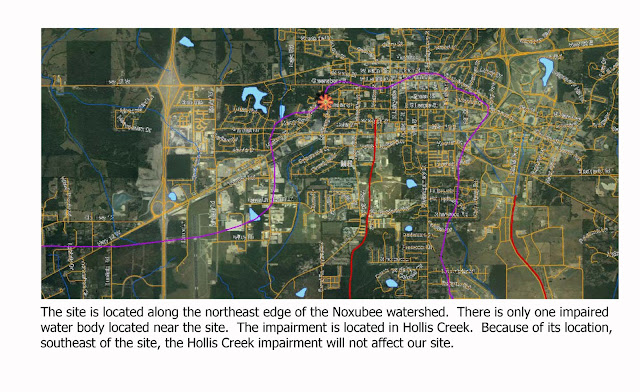 |
| Watershed Map |
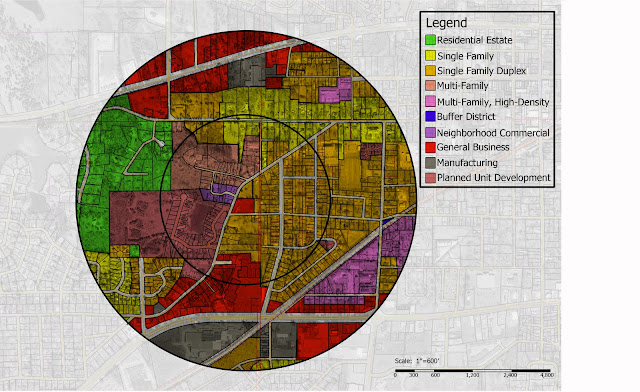 |
| Zoning Map |
 |
| Solar Study |
 |
| December Wind Rose |
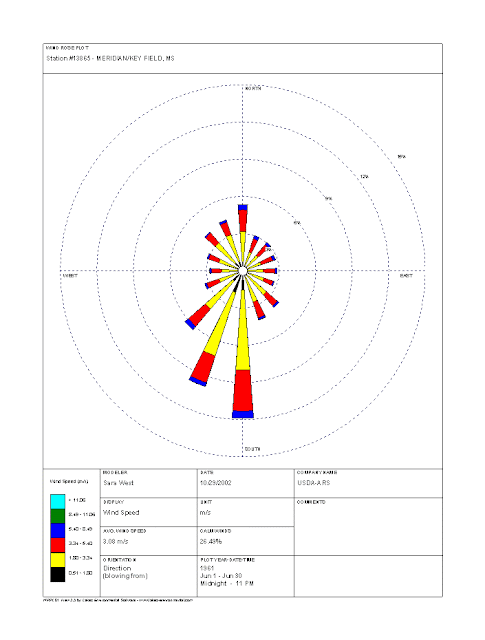 |
| June Wind Rose |
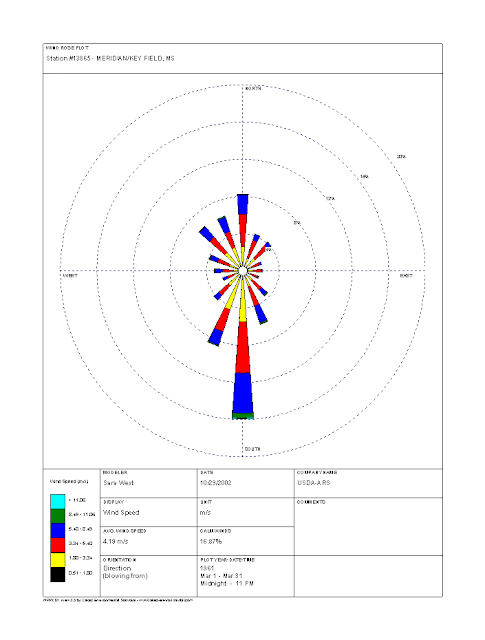 |
| March Wind Rose |
 |
| September Wind Rose |
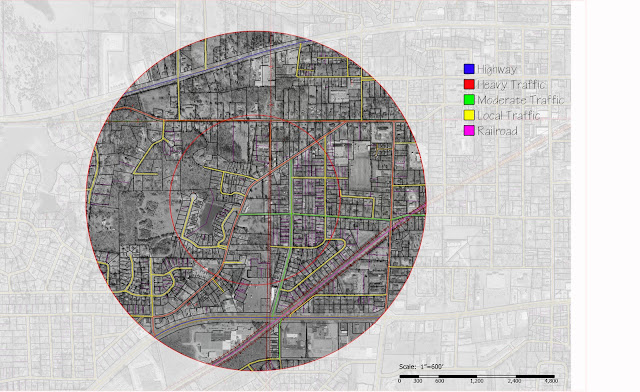 |
| Surrounding Road System |
 |
| Soils, Slope, and Topography Map |
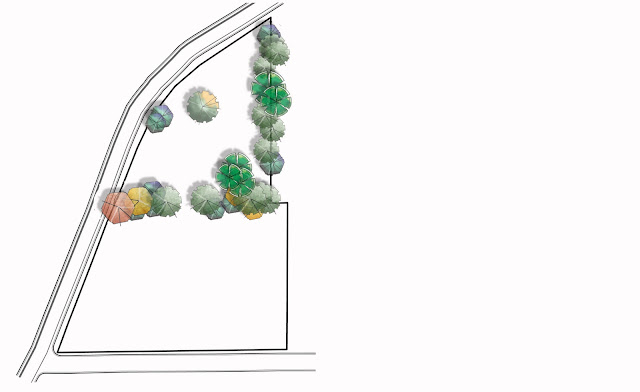 |
| Existing Vegetation |
This is by no means the entire inventory and analysis, but it is a brief overview of the major features existing on and around the site. Based on this information, I had a good starting point for the design process.
Subscribe to:
Posts (Atom)













